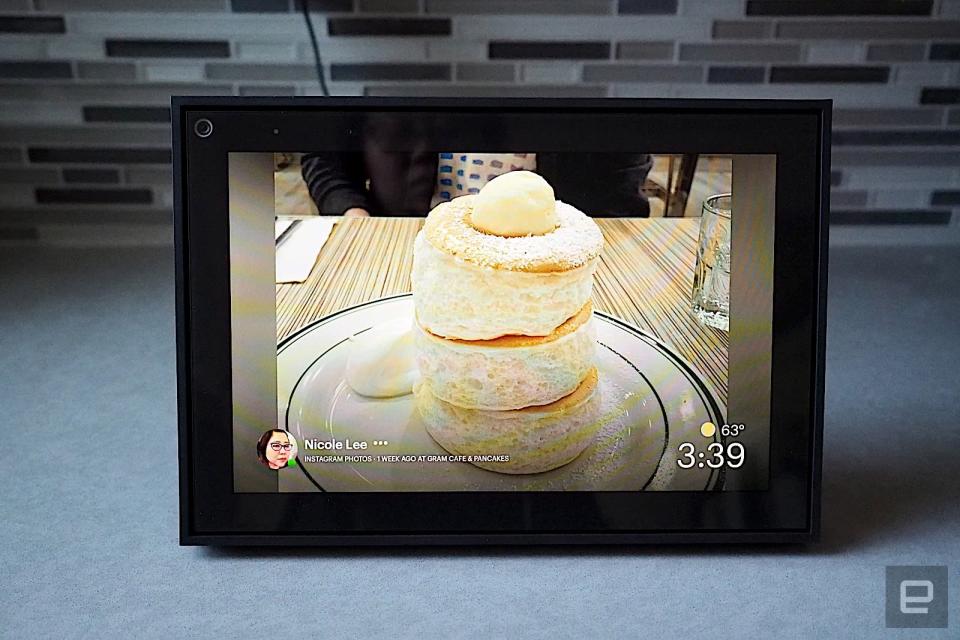Facebook Portal review (2019): A redesign doesn't ease privacy fears
Plus it's not much better than other smart displays.
When Facebook debuted its Portal video chat devices last year, they were met with a great deal of skepticism. After all, the company doesn't exactly have a stellar reputation on security and privacy. Following their release, Facebook faced even further scrutiny when it sent confusing messages on whether the devices collect data (they do) and when employees were caught leaving five-star reviews for them on Amazon. Oops.
Last month, the company announced new designs for 2019: a new 10-inch model plus an 8-inch Portal Mini. Aside from a hardware redesign, there are a few new features, the most notable of which is support for WhatsApp video calls, which should arrive on older Portals as well via a software update. Whether or not that's a compelling enough reason to get one is dependent on how important video chat is to you, and, importantly, whether or not you trust Facebook.
The biggest difference between the new Portal and the old one is its design. Last year's models came in either a giant 15.6-inch rotating display or a smaller 10-inch version that looked a little similar to an Echo Show. Of the two, I much preferred the 10-inch version, but both devices had a rather conspicuous design that might clash with your existing decor.
The 2019 version of the Portal, on the other hand, has been designed to better blend in with your home. The design is much more subtle, with a narrow, squared border around the edges that make it look more like a picture frame than a smart display. On the back is a plug-in tubular stand that adds to the picture frame aesthetic. It's not a bad look, but I did think setup was a little fiddly -- I had to rotate and push the tube in so that it connected properly.
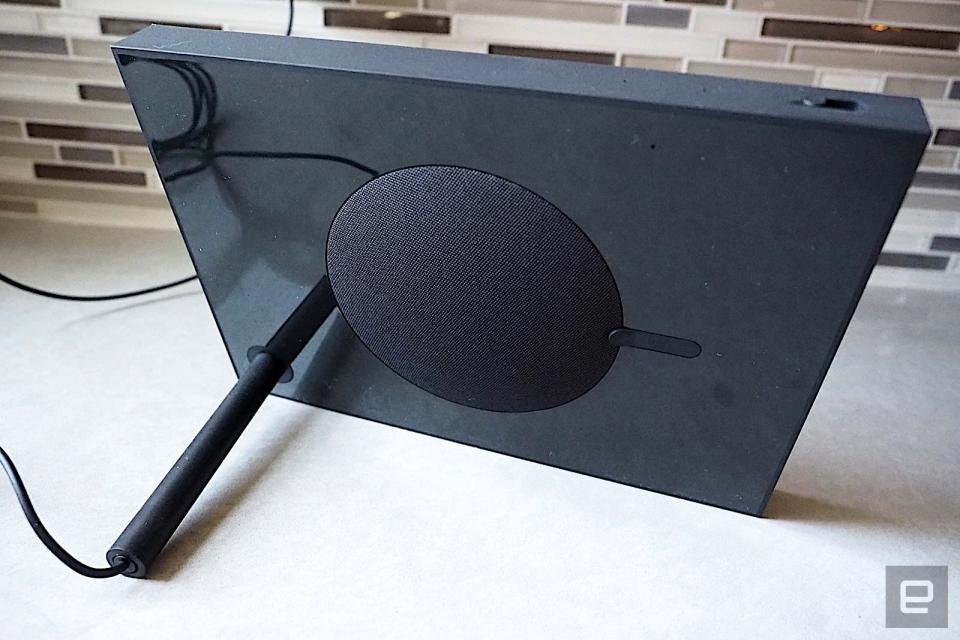
On the whole, however, I really like the new design a lot more than last year's editions. Plus, while the 2018 10-inch Portal could only be used in landscape mode, the new version can be rotated to be used in either portrait or landscape.
Another important design change is the camera toggle. Before, there was a physical cover for the camera along with a microphone mute button. Now, there's a two-stage toggle that can either enable both the camera and microphone, turn off the camera (a physical cover will slide over the lens) with the microphone enabled, or disable both functions altogether. An LED will glow red to indicate the microphone has been switched off.
The display's resolution is unchanged from last year -- it's 1,280 by 900 -- which I think is perfectly fine. Photos and videos look great, with bright color and contrast. Now, however, it has Adaptive Display tech, which darkens and brightens according to its surroundings. It's a feature that's been on Google displays for quite a while, but it's welcome to see it here all the same.
The sound has been upgraded as well. Now there are two full-range speakers plus a subwoofer, which is certainly better than the 10-watt speakers on the previous Portal. The audio has a lovely rich bass, solid mids and crisp highs. I still prefer the audio on the Echo Show and Nest Hub Max, but the Portal's sound quality is not bad at all. Aside from physical volume controls, the Portal also has on-screen volume controls for the speaker (denoted by the speaker icon) and for the call volume (denoted by the phone icon).
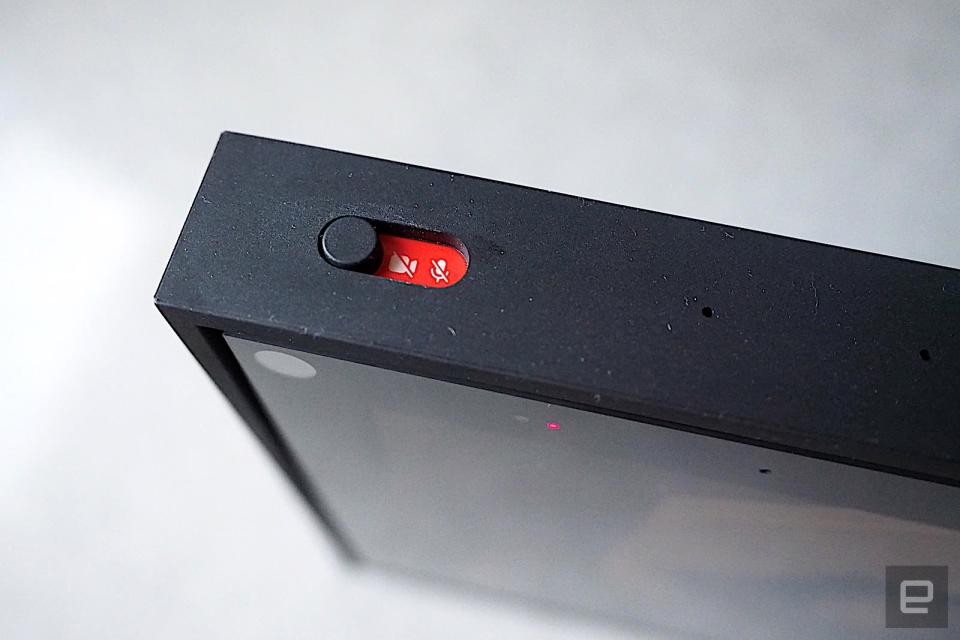
The Portal's interface remains relatively unchanged from last year. In standby mode, Portal will display what Facebook's calling a "SuperFrame," which appears to be a fancy term for wallpaper. You can choose which Facebook Photos album you want displayed, and it'll also occasionally show you birthday reminders and alerts for when your friends come online. Alternatively, you can download an optional Portal app that'll let you load the display with photos from your phone's camera roll. The app can also be used as an intercom of sorts to communicate with the Portal without having to go through Messenger or Whatsapp.
When activated, the home screen shows your Contacts screen, complete with favorite or recent contacts. You can then swipe right to get to the rest of the Portal's apps, which include a browser, a Food Network app (this is the same as the one on Echo Shows), news apps from CNN and Fox, Spotify, iHeartRadio, Pandora and Facebook Watch. There's no YouTube app here; the only way to access it is via the aforementioned browser. This leads to a less-than-stellar experience, especially since you can't use a voice command like "Alexa" or "Hey Portal" to control it.
There are a couple of apps that are new to this year's Portal. They are Photobooth, which lets you take photos of yourself and others, and Storytime, an AR storytelling experience for kids. Last year, Storytime was available only during video calls, but now the app can be used locally in the event that you want to tell a story to your kids with the Portal in front of both of you. I tried this out for a little bit on my own, and it was cute and fun. I can see how something like this would appeal to young kids.
I wasn't able to test them, but Facebook said that Amazon Prime Video and the ability to broadcast via Facebook Live would arrive on the Portal later in the year.
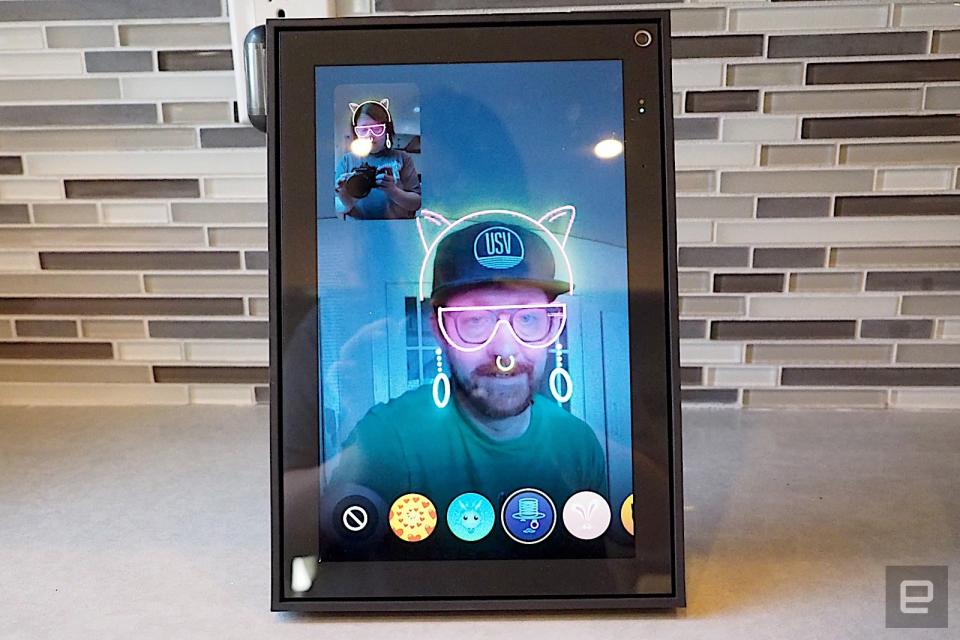
Of course, the primary reason you would get the Portal is to make video calls. The big upgrade with the 2019 Portal is that it now works with WhatsApp as well as Messenger. Messenger works straight away, since it shares the same login credentials as Facebook, but if you want to add your WhatsApp account, you'll need to undergo an additional step to set that up. All you need to do is scan the QR code with the app on your phone -- similar to how you'd set up WhatsApp on the desktop -- and you're ready to make or receive calls.
Messenger and WhatsApp calls are pretty similar for the most part, but there are a few differences. With Messenger calls, for example, I can use the "Hey Portal" voice command to initiate calls -- "Hey Portal, call my mom" would make it do exactly that. But you can't use the "Hey Portal" command with WhatsApp, apparently because Facebook and WhatsApp accounts are maintained separately. Instead, you'll have to make WhatsApp calls the old-fashioned way, by tapping on the screen and selecting the appropriate contact's name. That said, you can add WhatsApp contacts as Favorites so it's easier to call them from the home screen.
As for the calls themselves, there aren't many differences between the two services. I was able to use the same AR effects -- which are funny face filters you can put on yourself -- on both Messenger and WhatsApp calls, and the aforementioned Storytime feature is available on both. I was able to share songs over Spotify on both services as well. The one difference is AR games -- such as competing with your friend to chomp on virtual donuts -- which are available only on Messenger. The AR games are pretty fun, but I didn't miss them much on WhatsApp, so I don't consider this to be a big loss. The number of people you can have in a group call is different too. For Messenger, it's up to eight people, and with WhatsApp, it's up to four.
As with last year, one of the Portal's main selling points is its AI-powered camera that can pan and zoom to follow you around. You can switch to manual focus by pinching out on the screen, and if there are multiple people, you can tap on someone's face to zoom in and "Spotlight" them. I was very impressed with how well it "followed" me around the room, in both Messenger and WhatsApp calls, panning and zooming so I would remain in focus at all times. It certainly has a creepiness factor, but I can see how it would be useful for allowing you to walk around the room while remaining on the video call.
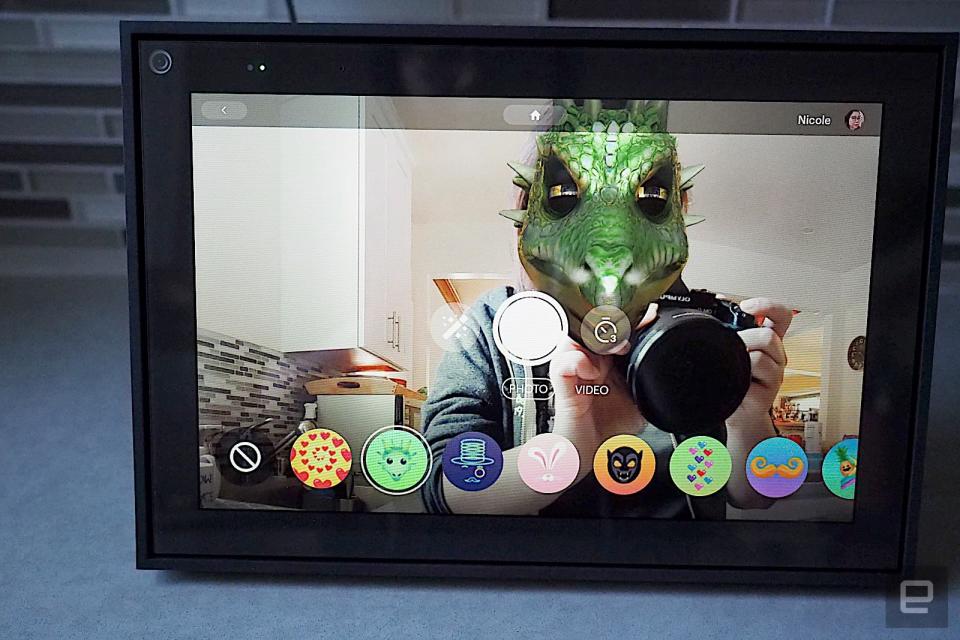
It should be noted however, that the Portal is no longer the only smart display that has this AI-camera technology; Google's Nest Hub Max has the same feature as well. Of course, the Nest Hub Max currently only works with the Duo chat service, which is far less popular than Messenger and WhatsApp. But if you're not a fan of Facebook and you prefer the Google ecosystem, then that might be a better alternative.
I also want to point out a few errors I encountered while testing the Portal. For one thing, I noticed that WhatsApp calls were a little bit lower in quality, at least compared to Messenger video calls. It seemed to have a touch more latency and wasn't quite as sharp and clear. Additionally, on one particular Portal-to-Portal call with Managing Editor James Trew, he encountered a rather bothersome audio feedback situation where he could hear his own voice a half second or so after he spoke. According to Facebook, this could be a bug due to pre-release software, but it's difficult to know for sure.
As before, the Portal comes with two different voice assistants: "Hey Portal" and Amazon's Alexa. The idea here is that "Hey Portal" can be used for on-device controls like making calls and launching apps, while Alexa is more for the usual Amazon voice assistant commands like looking up restaurant recommendations and controlling smart home gadgets like thermostats and lights. However, there is some overlap: both assistants can check the weather, set timers and alarms, and play music. I found myself defaulting to using Alexa for most non-device-specific functions regardless, so it wasn't too confusing, but I can see how this might take some getting used to.
Given Facebook's reputation, the biggest issues with the Portal concern privacy and security. The company attempted to appease such concerns with a few different measures. For one thing, all video and voice calls are end-to-end encrypted. The AI-powered camera features are processed locally on the device and not sent to Facebook's servers. During setup, the Portal gives warning statements that "Hey Portal" voice interactions are sometimes recorded and transcribed for a team to look at. But the chat logs can be deleted, and storage of the recordings can be blocked entirely if you so choose. It's worth noting that a lot of other smart displays from Google and Amazon do the same things.
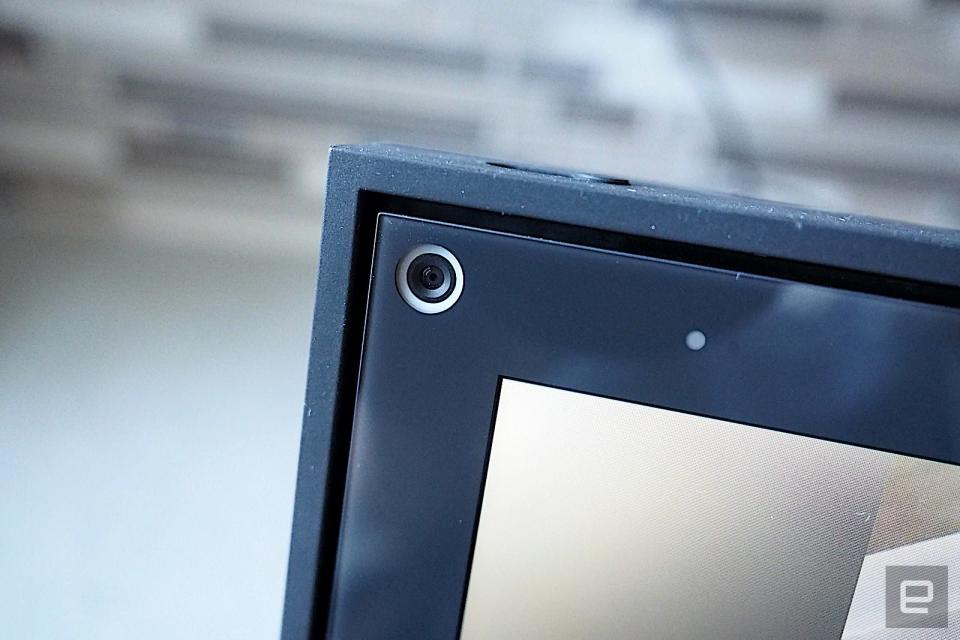
That said, this is Facebook we're talking about here, and it doesn't have a great track record when it comes to earning our trust. Just earlier this year, Facebook was discovered to have paid $20 gift cards to teenagers in order to access their data, and it didn't fess up to it until news reports came out. Combined with its inability or unwillingness to stop the spread of hate speech and disinformation, and it's understandable why someone might not want to purchase a device made by such a company.
Of course, despite all of these obstacles, Facebook still has millions of users, and Messenger and WhatsApp are two of the world's most popular chat applications. But take the video chat portion away, and the Portal is not an especially compelling smart display. It doesn't have the same number of apps and features as either an Echo Show or a Google Nest Hub. At $180 for the 10-inch Portal, it's priced lower than the Echo Show 2nd-Gen and the Google Nest Hub Max (both priced at $230), but it also isn't quite as functional.
If all you wanted was a video chat-centric device that works with the world's most popular chat apps, then the Portal is a fair choice. But both Amazon and Google make better smart displays, and the Nest Hub Max even has the same AI-powered camera feature. No, the Duo chat service isn't as well-known as either Messenger or WhatsApp. But given Facebook's poor reputation in other venues, that's a tradeoff I'm willing to make.

